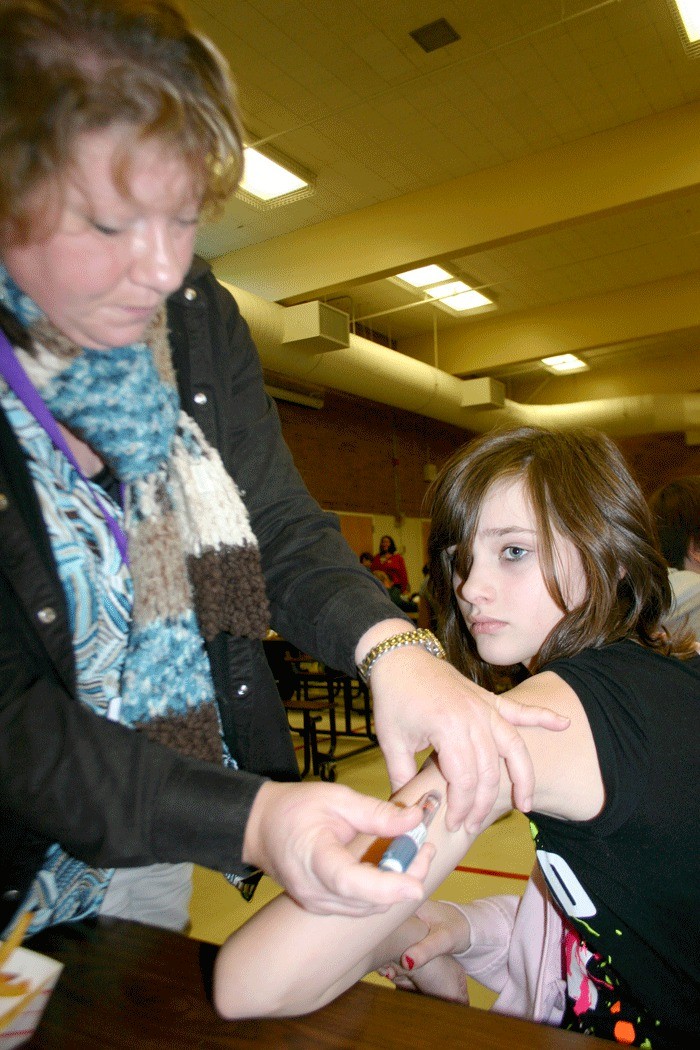The typical line-up of students suffering from stomach aches, rashes and coughs flowed into nurse Robbin White’s room but these problems are the easiest part of her job as one of three nurses serving the Oak Harbor School District.
With more than 5,600 students in Oak Harbor schools, White has her hands full as the sole nurse covering Oak Harbor Middle School, North Whidbey Middle School and Crescent Harbor Elementary School.
Nurses Chris Perkins and Rhonda Coker cover the remaining eight schools.
“I don’t think just the general population realizes there’s not a school nurse in every building,” White said. “What we’re finding as three nurses is we’re getting more and more complex medical students.”
Band-Aids and ice packs are the smallest parts of White’s job. She hauled out a six-inch thick binder of health plans just for Oak Harbor Middle School students with life-threatening food allergies, asthma, seizure disorders, diabetes, anaphylactic allergies requiring epinephrine injections and more. Then she opened two large drawers stuffed with boxes of medication necessary for individual students.
“A lot of our time is spent as nurses managing the life-threatening population we have,” White said, adding that students overall have more life-threatening health issues than ever, especially asthma and allergies that could potentially kill students.
Every day at lunch, White heads to the cafeteria to tend to diabetic students so they can remain with their friends and have time to eat. She helps them count carbohydrates and gives insulin injections; if these aren’t done precisely, the student can go into shock.
She’s also busy caring for various students who have gastronomy tubes, a feeding tube that goes into the stomach, plus students with catheters. Students in wheelchairs need assistance, as well as students with emotional distress. Only a registered nurse can administer rectal medication to students having seizures.
That’s in addition to the daily series of head bumps, physical education class injuries and colds.
“We can’t be everywhere at the same time and often things happen at the same time,” White said.
White switches between her three schools every day. By the time she gets to the next school, there’s a list of students seeking her help. In the case of emergencies, White is immediately called to another school, interrupting her efforts at the current school.
During a typical lunch, a steady stream of students seeking ice packs for bruised wrists, thermometers to check for the flu and help for uneasy stomachs arrived at White’s door. As White recorded symptoms and handed out disposable thermometers, she received a call to head to the other middle school for an emergency case, meaning she had to quickly finish helping those students and ask them to leave so she could move to the next school.
“It seems like the hardest thing is being in more than one place at one time,” White said.
White trains office staff to administer first aid, and emergency personnel are called depending on the seriousness of emergencies, but most of White’s duties can only be completed by a registered nurse.
“School nurses are drowning,” White said.
Due to lack of funding, many school districts have fewer nurses than schools.
The state doesn’t directly fund the nursing program, according to Superintendent Rick Schulte. The district receives funding for 46 certified staff for every 1,000 students so the district chooses how many nurses to hire. Certified staff include teachers, counselors, librarians, nurses and more.
In 1987, Schulte said there was one nurse serving the same number of students that three nurses serve now. A second nurse arrived in 1990. The district has had three nurses for more than 10 years.
With the nationwide shortage of nurses in hospitals, there’s also a shortage of school nurses.
“We feel very fortunate to have three,” Schulte said, adding that it’s difficult to find registered nurses who also have their certification to be a school nurse, which all three OHSD nurses have.
“The students’ needs for nurses has risen to more than it used to be,” Schulte said, citing the growing number of students with life-threatening allergies, diabetes and more. “The wide variety of things they do and decisions they have to make makes it a very important job.”
In 1987, the nurse mainly administered hearing, vision and scoliosis screenings but today, “The range of service nurses provide is very broad,” Schulte said.
Alongside medical duties, nurses also speak in health classes when called upon and would assist if there was ever a pandemic of illnesses like swine flu or pertussis in the school district, Schulte added.
“I would love to have another nurse. That would really help our work load,” White said. “We also could use health room assistants.”
The district has one assistant, at Hillcrest Elementary School, who helps with diabetic students.
White’s first school nursing job after graduating from nursing school at the University of Washington was for Shoreline School District, where she worked in one elementary school. She moved to the Oak Harbor School District in 2004 and started with five schools.
“I miss that I don’t get to know the kids as well because I’m moving from building to building,” White said.
Before becoming a school nurse, White worked in pediatrics at Swedish Hospital. After working hours that kept her from seeing her family and after dealing with the deaths of many children at the hospital, White appreciates the hours and students at her current job.
“I chose to be a school nurse because I love children and working with families,” White said.
“The nice thing is, everyone’s supportive,” White said of those she works with. “But it comes down to no money.”



